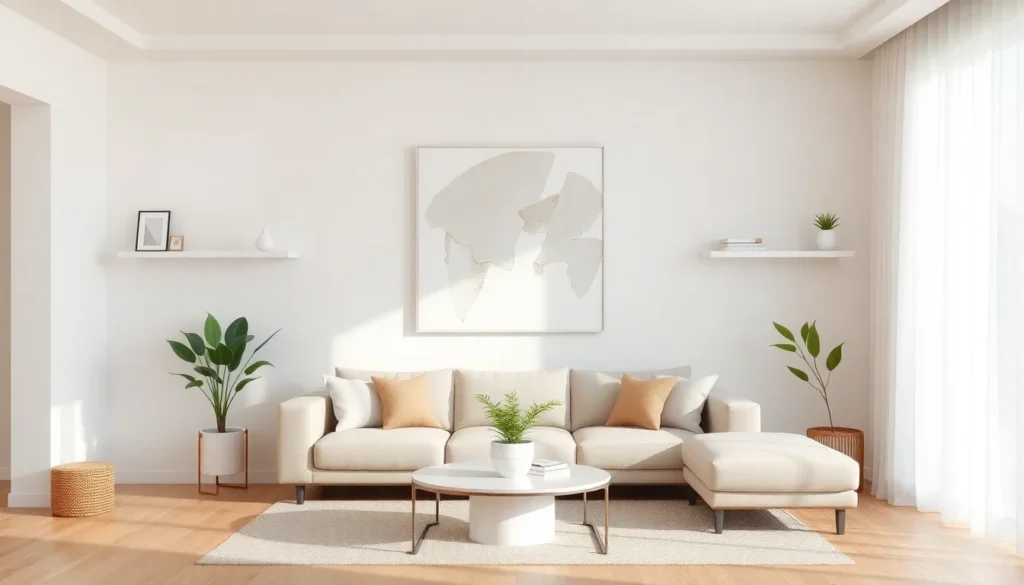Table of Contents
ToggleImagine walking into a living room that feels like a breath of fresh air—clean lines, soothing colors, and just the right amount of charm. Minimalist wall decor transforms ordinary spaces into extraordinary retreats. It’s not just about less clutter; it’s about creating an atmosphere that invites relaxation and inspires creativity.
Ditch the overwhelming gallery walls and embrace simplicity. With the right minimalist touches, your living room can become a haven that speaks volumes without saying much at all. From understated art pieces to clever shelving, minimalist decor allows personality to shine through without the chaos. Get ready to discover how a few thoughtfully chosen elements can elevate your space and leave your guests wondering if you hired a designer—or if you just have an eye for the elegant and essential.
Understanding Minimalist Design
Minimalist design emphasizes simplicity and functionality. It focuses on reducing visual clutter while maximizing aesthetic appeal.
Key Principles of Minimalism
Simplicity serves as the foundation of minimalist design. Clean lines and open spaces promote a sense of tranquility. Functionality enhances the design, ensuring that each piece serves a purpose. Limited color palettes contribute to an uncluttered look. Negative space becomes crucial, allowing elements to breathe and stand out. Intentionally chosen decor pieces create a focal point, drawing attention without overwhelming the senses. Each element should reflect personal style, merging form with simplicity for a cohesive appearance.
Benefits of Minimalist Decor
Minimalist decor offers numerous advantages for living spaces. Enhanced functionality transforms environments into vibrant, efficient areas suited for various activities. Reduced clutter fosters mental clarity, allowing individuals to focus on what truly matters. A soothing atmosphere improves relaxation and well-being. Additionally, minimalism simplifies maintenance, requiring less effort to keep spaces looking pristine. Versatility in decor items enables easy incorporation of personal touches, allowing homeowners to express their individuality. Finally, minimalist decor often contributes to a timeless aesthetic, ensuring styles remain relevant for years.
Types of Minimalist Wall Decor

Minimalist wall decor encompasses various styles and elements that enhance the living room. Below are two popular categories.
Artwork Options
Choosing artwork carefully adds character without overwhelming the space. Abstract prints with soft colors and geometric shapes fit well within a minimalist aesthetic. Line art is also a great option, offering elegance through simplicity. Black and white photographs provide classic charm while maintaining a clean look. Selecting a single large piece instead of multiple smaller ones creates a focal point, allowing it to be appreciated fully. Limited color palettes within the artwork ensure it complements existing decor. Minimalist art promotes a sense of peace, aligning with the overall design philosophy.
Shelving Solutions
Incorporating simple shelving balances visual interest and space efficiency. Floating shelves provide a sleek, unobtrusive option. They allow for the display of carefully selected items without taking up floor space. Use open shelving to highlight curated collections or meaningful artifacts. Simple, styled display arrangements contribute to a clutter-free environment. Avoid overcrowding shelves, which detracts from the minimalist effect. Neutral finishes like light wood or metal support a cohesive look throughout the room. A well-thought-out shelving system enhances functionality while contributing to the serene aesthetic of minimalist design.
Choosing the Right Colors
Selecting appropriate colors creates a balanced atmosphere in minimalist living rooms. Color choice impacts mood, perception, and overall aesthetic.
Neutral Palettes
Neutral palettes set a calming tone and serve as the foundation for minimalist design. Shades like white, beige, and gray enhance natural light and make rooms feel more spacious. Soft colors unify decor and create cohesiveness, allowing decor elements to shine. Selecting warm or cool neutrals affects the ambiance differently; warm tones invite warmth, while cool tones promote tranquility. Light neutrals particularly work well in smaller spaces, making them feel airy and expansive.
Accent Colors
Accent colors add personality without overpowering the minimalist theme. Shades like muted pastels or deep jewel tones create focal points without cluttering the visual landscape. Choosing one or two accent colors ensures a cohesive look, perfect for pillows or artwork. Incorporating these colors in small doses maintains the minimalist aesthetic while providing visual interest. It’s important to select accents that complement the neutral base; this enhances harmony and elevates the overall decor.
Incorporating Texture and Materials
Incorporating diverse textures and materials not only enriches minimalist wall decor but also builds visual interest in the living room.
Natural Elements
Natural elements play a significant role in minimalist design. Incorporating wood, stone, or plants introduces organic warmth into the space. One popular choice is reclaimed wood, which adds character and uniqueness. Soft textiles, such as cotton or linen, can balance the sturdiness of hard surfaces. Incorporating greenery, whether through potted plants or wall-mounted planters, brings life and freshness indoors. Natural fabrics in neutral tones work well on upholstered pieces, adding depth without cluttering the aesthetic. Effortlessly intertwining these elements promotes a serene and inviting atmosphere.
Industrial Materials
Industrial materials enhance the minimalist approach by offering a raw, authentic feel. Concrete finishes contribute an interesting texture on walls, creating a striking backdrop. Metal accents bring an edgy touch to the decor, often seen in frames or shelving units. Utilizing blackened steel or brass elevates the overall design without being overpowering. Glass elements offer transparency, allowing light to flow through the space while maintaining a sleek appearance. Combining these materials supports a modern, streamlined look, reinforcing the minimalist ethos without sacrificing style.
Tips for Arranging Decor
Arranging decor in a minimalist living room creates harmony and aesthetic appeal. Smart placement enhances the overall atmosphere while reflecting personal style.
Creating Balance
Balance in wall decor brings visual stability to the living room. Consider symmetry when selecting pieces, pairing artwork or shelving units for a cohesive look. Use equal weight of different elements across the wall to avoid unevenness. Incorporating similar textures or colors can unify diverse pieces, enhancing harmony. Varying sizes of decor can also maintain intrigue while keeping balance. Each piece should contribute to a sense of order and tranquility, embodying the principles of minimalist design.
Focal Points
Focal points draw attention and define the room’s character. Choose a significant artwork or a unique shelving unit that stands out against the backdrop of neutral walls. Position larger items centrally to create an inviting atmosphere. Incorporating contrasting colors or textures for focal points adds interest without overwhelming simplicity. Each focal piece should provoke curiosity and engagement, enhancing the minimalist aesthetic. Allow these elements to guide the viewer’s gaze and become conversational starters.
Embracing minimalist wall decor in the living room can significantly enhance the overall ambiance of a space. By prioritizing simplicity and thoughtful design choices, homeowners can create a serene environment that reflects their personal style. The strategic use of color, texture, and carefully selected decor pieces fosters a calming atmosphere while maintaining functionality.
Incorporating these principles not only elevates the aesthetic appeal but also promotes mental clarity and well-being. As individuals curate their living spaces with minimalist decor, they invite tranquility and sophistication into their homes. Ultimately, the journey toward a minimalist living room is about finding balance and creating a space that feels both inviting and uniquely personal.




